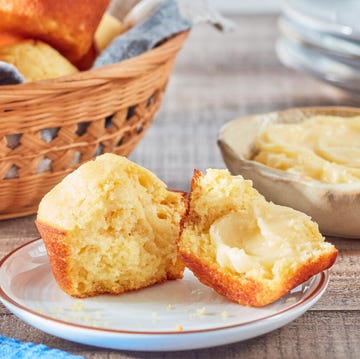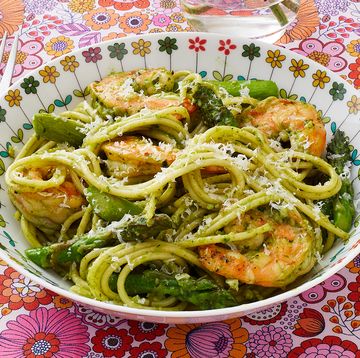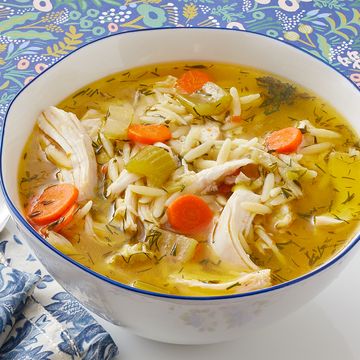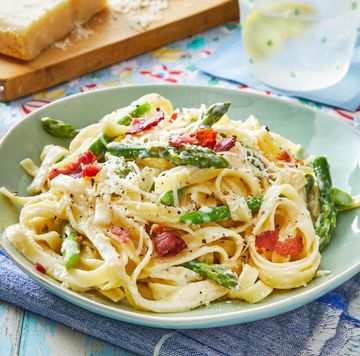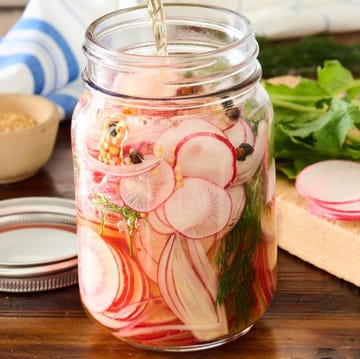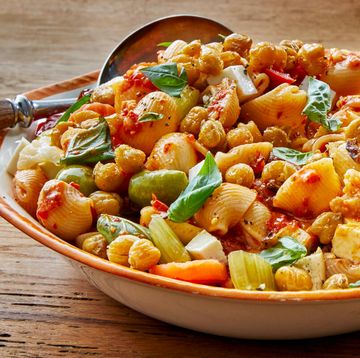1Artichokes
 Westend61//Getty Images
Westend61//Getty ImagesOne of the best things about spring is all the flower buds—artichokes included! The green or purple artichoke buds are harvested before reaching maturity for the edible parts at the base of the petals, heart, and center of the stem.
Storage tip: To store, sprinkle them with water before placing in a plastic bag and storing in the fridge for up to five days.
SHOP CUTTING BOARDS
2Beets
 Roy Morsch//Getty Images
Roy Morsch//Getty ImagesBright, sweet beets are the perfect addition to any spring salad. The cool-season crop thrives in early spring when you can plant it directly into the ground. In seven to nine weeks, you can harvest the root vegetable and turn it into beet hummus, beet pickled eggs, and so much more!
Storage tip: To maintain moisture, cut the greens and store them in a perforated plastic bag in the crisper for up to two weeks.
Advertisement - Continue Reading Below
3Asparagus
 Westend61//Getty Images
Westend61//Getty ImagesAsparagus is harvested in early to mid spring, when its tender spears are at their best. Look for asparagus that feels firm, not rubbery or soft. It’s delicious when grilled or roasted, and cooks surprisingly fast. Plus, asparagus is one of the few perennial vegetables you can grow yourself—just plant the crowns in a sunny spot in mid-spring.
Storage tip: Trim the ends of the asparagus and place them in a jar of water, like you would with flowers. Keep them in the fridge for up to five days.
4Snap Peas
 ADX Collections//Getty Images
ADX Collections//Getty ImagesGarden peas, also known as snap peas, are available year-round but taste sweetest in the spring. Choose crispy pods, then shuck and steam them. They can be used in a wide variety of recipes. Peas are also easy-to-grow; plant about six weeks before the last frost date, and give them a trellis to climb.
Storage tip: They are best stored whole in a bag or container in the crisper drawer of your fridge, and should last up to a week.
Advertisement - Continue Reading Below
5Swiss Chard
 Dave Le//Getty Images
Dave Le//Getty ImagesSwiss chard is both beautiful and delicious with its rainbow-hued stalks and bright green leaves. You can chop it and add to frittatas, soups, or side dishes. It's also easy to grow in full sun.
Storage tip: To store, wrap the stalks in lightly damp paper towels before placing them in a plastic bag and storing them in a crisper drawer. Don't worry if the bag won't close―it's actually better to let the leaves breathe a little.
SHOP COOKWARE
6Arugula
 by JBfotoblog//Getty Images
by JBfotoblog//Getty ImagesThe slightly peppery bite of arugula adds flavor to salads, pasta dishes, or pizza toppings. It's available year-round but is found in farmers' markets in spring. Sow the seeds as early as the soil can be worked, and enjoy the pleasant flavor in about six weeks.
Storage tip: To keep the leaves from wilting, wrap the arugula in paper towels, place in a plastic bag, and stash in the fridge for up to a week.
Advertisement - Continue Reading Below
7Spring Onions
 fahadee.com//Getty Images
fahadee.com//Getty ImagesOften confused with scallions, spring onions have more of a bulb-shaped end. These sweet, delicious onions are best—as you'd guess—in spring! Roast them whole to savor their flavor, add raw slices to salads, or pickle them to enjoy all year.
Storage tip: To store, seal them in a plastic bag in the crisper drawer for up to two weeks.
8Rhubarb
 Sergio Amiti//Getty Images
Sergio Amiti//Getty ImagesRhubarb has a tart kick that makes it ideal in both savory and sweet recipes. It's generally only available in fresh form in the spring, and it's also one of the few vegetables that's a perennial. You'll harvest rhubarb for years from your garden if it likes the growing conditions.
Storage tip: To store, trim off all the leaves (which can be poisonous!), place in a perforated bag, and stash in the crisper for up to three weeks.
Advertisement - Continue Reading Below
9Radishes
 Claudia Totir//Getty Images
Claudia Totir//Getty ImagesRadishes have a spicy bite that makes them tasty for snacking or adding to salads. Plus, the leaves are edible, too! They're especially delicious when purchased fresh from the farmers' market, which often features heirloom or unusual varieties. Or grow them yourself; some types are ready to harvest in less than a month.
Storage tip: They will last up to two weeks when in a perforated bag in the crisper drawer.
10Spinach
 Eriko Koga//Getty Images
Eriko Koga//Getty ImagesSpinach is available year-round, but it's often extra-sweet in spring. Of course, it's great in so many spinach recipes: raw in spinach salads, basked in classic spinach pie, or mixed up in a super-easy spinach dip. Spinach is quick and easy to grow, too.
Storage tip: To keep it fresh, wrap spinach in paper towels and then store in a plastic bag in the fridge for up to five days.
SHOP DINNER PLATES
Advertisement - Continue Reading Below
11Ramps
 Winslow Productions//Getty Images
Winslow Productions//Getty ImagesRamps are actually wild leeks, which have an oniony-garlicky flavor that mellows when sautéed. Their season is incredibly brief, so snag them when you see them. You can also pickle them so you can have the flavor all year long! Typically, you'll only find them at farmers' markets.
Storage tip: They will last only a few days, so use them quickly. In the meantime, wrap them in a plastic bag and store them in the fridge.
12Carrots
 Devin Hart//Getty Images
Devin Hart//Getty ImagesCarrots love cool weather, so they're sweetest in the coldest months of the year. They're sold at supermarkets year-round, but baby carrots often are available only at farmers' markets in the spring. Remove the tops but do not peel them until you're ready to use.
Storage tip: Place them in a resealable bag or container and store them in the coldest part of your fridge for up to a month.
Advertisement - Continue Reading Below
Advertisement - Continue Reading Below
Advertisement - Continue Reading Below


